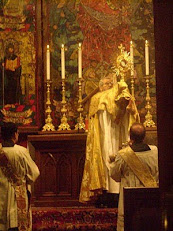Preface & Caution
I'm going to say up front that I am a bit out of my depth here. My time was spent in the Episcopal Church. I know a number of lay people and priests within the Continuing Churches and have a passing acquaintance with a bishop or two, but it's not a world that I can write about as an insider. I hope I do it justice.
Introduction
Most media attention since the announcement of the forthcoming apostolic constitution creating special ordinariates for Anglicans has been devoted to Forward in Faith in the United Kingdom, which represents traditionalists within the Church of England, and to the Traditional Anglican Communion (TAC), which represents a reported 400,000 communicants who have left the Anglican Communion. When we zoom in on the US, the picture is different. Forward in Faith's US affiliates are largely those who remain within the Episcopal Church or did so until quite recently. Two of its leaders who spoke at last weekend's conference in London seemed to indicate that they will be taking a pass on the ordinariates, at least as a group. This decision leaves TAC's American affiliate, the Anglican Church in America, with around 5,000 members, as the largest group in the US that we know to be looking at reunion with the Holy See...
Read the rest in today's posting on his blog Sub Tuum.
Br. Stephen made a very interesting point in his posting on the first day of the Forward in Faith meeting last week in the UK. Writing on his blog, he reminds us:
Finally, to sound a bit more like a monk than a bureaucrat, remember that in their statement on the day the apostolic constitution was announced, the Bishops of Ebbsfleet and Richborough used the analogy of a people gathering by the Red Sea. As someone who gets to chant all the great psalms of the Exodous every week, I encourage you to put the dramatic image of Charlton Heston splitting the waters out of your head and instead remember the longer story, which is a tale of snakes, thirst, murmuring, rebellions, and long wandering before the journey was completed. Of all who left Egypt, only Joshua and Caleb entered the Promised Land, but God thought it that was worth it.
Read the rest of his post on his blog Sub Tuum.
In a post on Monday, Br. Stephen explores the varieties of Anglican churchmanship. He begins his post "High & Hazy, Low & Lazy, Broad & Crazy" with:
The title of this piece isn't a diatribe. It's the old rhyme that Episcopalians used to poke fun at the parties within Anglicanism. It occurs to me after the last week that there are a number of Catholics out there who could use a mapping of the Anglican world...
To see Br. Stephen's description, check out the rest of the post at Sub Tuum.














No comments:
Post a Comment